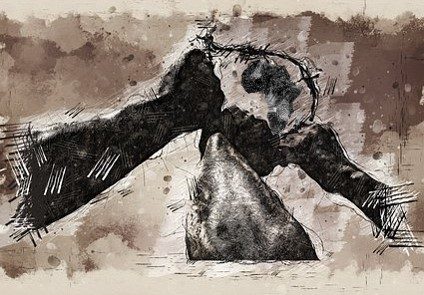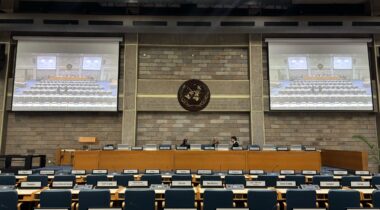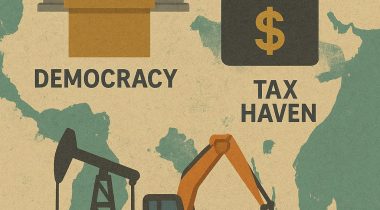
Tax Justice Network ■ The CFA Franc as a vivid symbol of colonial continuities in Francophone Africa

In the first article of our Black Lives Shattered edition of Tax Justice Focus, Dr N.S. Sylla explains how monetary policy in Africa has been dominated by a consensus formed in Europe and the United States. In France’s former colonies in West and Central Africa this has helped preserve the substance of empire long after its formal end.
Dr. Ndongo Samba Sylla *
The history of money and finance in the former French colonies south of the Sahara presents remarkable continuities, despite the political and institutional changes that occurred with the decolonisation process in the 1960s. The most obvious symbol of these continuities is no doubt the CFA franc. The acronym of this currency created in 1945 by the French provisional government originally stood for franc of the French colonies in Africa. It still circulates in eight countries in West Africa and six countries in Central Africa without its founding principles having been altered.

To have a proper sense of the history of French monetary imperialism in Africa, one has to go back at least to the mid-19th century. With the abolition of slavery in France in 1848, the French state had to compensate French slave owners for the loss of their “movable” property. Part of the financial compensation had been used to set up colonial banks under the authority of the Bank of France. This was the case of the Bank of Senegal, created in 1853 by a decree of Louis Napoleon. Unlike the other colonial banks whose headquarters were located in metropolitan France, the Bank of Senegal was based in Saint-Louis, in the north of Senegal. It started in 1855 as a loan and discount bank. Being under the financial control of the Bordeaux trading houses, its role was to promote their export and import activities to the detriment of their local rivals who suffered discrimination in accessing credit. Following its dissolution in 1901, the Bank of Senegal was succeeded by the Bank of West Africa, a private bank that had a monopoly on the issuance of francs in the French colonial empire south of the Sahara.
African people had for a long time resisted the imposition of the French currency. For their trade, but also for religious purposes, they used currencies like the cowries, a shell from the Indian Ocean, and the manilla (a bracelet). They were aware that the acceptance of the colonial currency would disrupt their trade and more importantly would make them economically subordinated to the diktats of their colonial masters. If you no longer have control over your currency as a nation, you no longer have control over what you produce, consume and exchange. As the ban on the import of cowries and the obligation to pay taxes in the colonial currency were not always effective, colonial administrators were often obliged to use legal sanctions and physical force. Their sense of masculinity often suffered from the defiant attitude of African women who did not want to use the franc in their daily trade. Only the creation of the CFA franc would end decades of resistance from ordinary people against the French imperial monetary order.
The Bank of West Africa was replaced in 1955 by two public issuing institutions that four years later became the Central Bank of West African States and the Central Bank of Equatorial African States and Cameroon, renamed the Bank of Central African States. These two central banks each separately issue a currency whose acronym is the CFA franc: the franc of the African financial community in the first case; the franc of financial cooperation in Central Africa in the second. In the mid-1970s their headquarters were moved to Dakar (Senegal) and Yaounde (Cameroon) respectively. Their staff was ‘Africanised’ in the same process.
The ‘Africanization’ of the management of the Central Bank of West African States and the Bank of Central African States did not put an end to the colonial character of the monetary system. The CFA franc still functions according to the same principles and purpose established during the colonial period. Its rigid peg to the French currency (franc then euro, from 1999) and the freedom of transfers between France and countries using the CFA franc were not abolished after independence. Similarly, the French government’s direct control over monetary and exchange rate policy is still exercised through its representation in the organs of the two central banks with a veto power that has become implicit over time, and the obligation for the latter to deposit part of their foreign exchange reserves with the French Treasury (50 percent since the mid-2000s).
The purpose of this ‘monetary arrangement’ from its origin to the present day is to maintain satellite economies that are ‘complementary’ to the French economy. That is, economies that serve as cheap sources of raw material supplies and captive outlets.
The fixed parity reduces transaction costs and protects French companies (and now all foreign companies operating in euros) from exchange rate risk. The structural overvaluation of the CFA franc, the artificially high level of its value against the reference currencies, tends to favour imports, including luxury goods, to the detriment of exports.
The fixed parity thus constitutes a kind of trade preference granted to the euro zone, since African countries cannot use their exchange rate as an instrument to boost at times the price competitiveness of their exports. Finally, it deprives the Central Bank of West African States and the Bank of Central African States of the possibility of using the exchange rate to absorb shocks. Thus, in the event of a crisis, the need to defend the peg implies a reduction in public expenditure and credits to the economy, as well as an increased dependence on external financing flows.
As for the freedom of transfer, it allows for the free investment and disinvestment of French capital as well as the repatriation of profits, dividends, etc. In resource-rich CFA countries, this freedom is often associated with significant financial bleeding. For example, over the period 1970-2008, illicit financial flows from Côte d’Ivoire and Cameroon are respectively estimated in 2008 US dollars at 66.2 billion and 33 billion, which was 6 times and 13 times higher than their respective stock of external debt.
In addition to the handicaps resulting from an overvalued exchange rate and the outward transfer of local economic surpluses, the behaviour of the banking sector retains its colonial character.
In CFA countries, credits to the economy remain low, with short maturities and prohibitive interest rates. Loans are mainly oriented towards the trade sector to the detriment of invesmtnet in agriculture and manufacturing. Bank loans are primarily targeted at large companies and governments to the detriment of SMEs in general. The decline in the market share of French banks in CFA countries has not changed this general observation. The banking landscape has become less oligopolistic but is still largely dominated by foreign banking groups. In Senegal, for example, the latter control more than 90 percent of banking assets.
Thus, domestic production in CFA countries is penalised on the one hand by the low level and inadequacy of the credits to the economy and on the other by the overvaluation of the exchange rate. This pattern is aggravated by trade liberalisation policies and those dictated by the ideology of fiscal austerity.
The persistence of neo-colonial monetary and financial relationships has favoured neither structural transformation nor regional integration, and has done even less for the economic development of the CFA countries, 9 out of 14 of which are among the Least Developed Countries. In terms of health and education achievements, CFA franc using countries occupy the lowest ranks worldwide. Among a total of 189 countries, Niger, Central African Republic and Chad had the lowest score on the 2020 Human Development Index. Looking from a long term perspective, average real incomes have stagnated or declined in five of the biggest CFA franc using economies: Cote d’Ivoire, Cameroun, Gabon, Senegal and Congo Republic.

If this monetary bond did not prevent the commercial and financial decline of France in its sphere of influence, it has nonetheless contributed to the institution of centralised political regimes that are more responsive to the priorities of the French government, French companies and foreign investors than to the interests of their citizens. For example, in oil-exporting CFA countries such as Chad, Gabon, the Republic of Congo and Equatorial Guinea, the ‘president for life’ model remains the norm, notwithstanding the frequent organisation of formal elections with a foregone conclusion.
In other words, the CFA franc existence favours a particular type of political leadership. Those who can aspire to lead CFA countries are those who will not question its limitations. It is these leaders that have enjoyed the active solidarity and support of the French government over the last six decades.
In the face of growing protests against this colonial relic led by pan-Africanist social movements and intellectuals, France, in alliance with Côte d’Ivoire, decided in December 2019 to soften its stance on the West African CFA franc. As with previous CFA franc reforms, the current one is very limited in scope. Its motivation is to tackle the embarrassing symbols – the name of the currency, French representation within the Central Bank of West African States and the control of the French Treasury over the latter’s foreign exchange reserves – while ignoring the points that African economists criticise: the existence of a formal link of monetary subordination between France and the CFA countries, the fixed parity with the euro, the freedom of transfers, and also the existence of two monetary unions that have no other foundation than colonial history.
While the abolition of the CFA franc does not in itself guarantee that its member countries will develop more equitably and rapidly, extending its life expectancy cannot but hinder any prospect of political and economic emancipation of African peoples.
You can access the entire Black Lives Shattered edition of Tax Justice Focus here
** Dr. Ndongo Samba Sylla is a Senegalese development economist and researcher at the West Africa Office of the Rosa Luxemburg Foundation. He is the co-author with Fanny Pigeaud of Africa’s Last Colonial Currency: The CFA Franc Story (London: Pluto Press, 2021).
Related articles

The best of times, the worst of times (please give generously!)

Admin Data for Tax Justice: A New Global Initiative Advancing the Use of Administrative Data for Tax Research

2025: The year tax justice became part of the world’s problem-solving infrastructure

Bled dry: The gendered impact of tax abuse, illicit financial flows and debt in Africa
Bled Dry: How tax abuse, illicit financial flows and debt affect women and girls in Africa
9 December 2025

Two negotiations, one crisis: COP30 and the UN tax convention must finally speak to each other

‘Illicit financial flows as a definition is the elephant in the room’ — India at the UN tax negotiations

Taxation as Climate Reparations: Who Should Pay for the Crisis?

Tackling Profit Shifting in the Oil and Gas Sector for a Just Transition



Please CHECK YOUR FACTS BEFORE SOUNDING OFF WITH ARTICLES OF THIS KIND .
This is a singularly misguided article that fails to recognise one of the outstanding achievements of French decolonisation. They left behind a zone with monetary stability and free from the massive devaluations and damaging hyper-inflation that has characterised all former British colonies. Interest rates have moreover been much more stable, never getting near the impossible rates (like 40% per annum) sometimes experienced in countries like Ghana. And yes, the CFA regime has made it difficult for Governments to endlessly print money, and required them to try to live within their means.
Of course, there is no denying France’s neo-colonial relationship with former African colonies, and the long shadow cast by Jacques Foccart, but one needs to give praise where it is due. There may be scope for floating the CFA against the Euro and other currencies, but it is very important that Francophone Africa hang onto this institution which has been a source of stability in a sea of anarchy.
I was starting to become an enthusiastic follower of Tax Justice, but this article has sapped my confidence. How many other half-baked arguments has Tax Justice been advancing.
We respectfully disagree. The CFA has indeed suffered “massive devaluation” – one vast overnight one (from memory, 1994?) when a CFA suddenly became half as valuable. Such a monetary anchor has some advantages, but it is also a strait jacket. Monetary stability, but could one argue that the Francophone economies have performed better than the others? It’s a hard argument to make. Convertibility into Francs then Euros, and consequent over-valuation for a lot of the time (hence that massive devaluation) served Francophone African elites, helping them spend freely in Paris, while making local economic sectors (agriculture etc.) less competitive against imported goods. It’s a mixed bag, for sure. But a neo-colonial system, for sure. Britain of course has been much worse, keeping control of a lot of the money flows via its “Spiderweb” of tax havens.